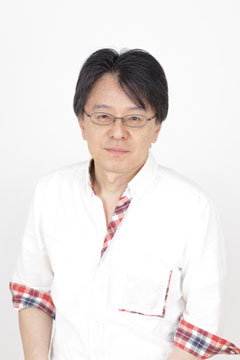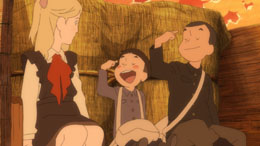Interview with Mizuho Nishikubo
 |
Mizuho Nishikubo Born in Tokyo on January 15, 1953, Nishikubo is a longtime and most trusted collaborator of Mamoru Oshii, and has participated as sequence director (but under his real name of Toshihiko Nishikubo) in all Oshii's works since Patlabor 2: The Movie (1993), namely Ghost in the Shell, Cannes Palme d'Or-nominated Innocence and Golden Lion-nominated The Sky Crawlers. It is said that Oshii's movies would not look the same without his contribution. He uses his alias Mizuho Nishikubo when he directs. After graduating from Waseda University, Nishikubo joined Tatsunoko Production in 1975, and in 1979 became a protégé of Osamu Dezaki, one of Japan's most respected animation directors. His collaborations with Dezaki include TV series Lady Oscar (1979) and Ashita no Jo 2 (1980). Nishikubo made his directorial debut in 1983 with Mitsuru Adachi's romantic comedy Miyuki (1983, TV series). Other credits include Red Photon Zillion, (1987, TV series) Legend of Heavenly Sphere Shurato (1989, TV series), Video Girl Ai (1992, OVA) and Otogi Zoshi (2004, TV series). He also directed the music clip Tsepi i kol'tsa / Chains & Rings (2003) for the hugely popular Russian rock star Linda. His movie, Musashi: The Dream of the Last Samurai screened in Locarno, Sitges, Warsaw and Stockholm. |
How did you get involved into this project?
Personally, I've always been very interested in the historical period from the 30s onward, when Japan relentlessly throws itself into that conflict one step after another. I confess I had always wanted to confront myself with a story set in that period. Then this project suddenly came across my desk. But it was about a part of that war that I did not really know. And even most Japanese don't. It was not set on the Asian continent or in the Pacific, but on a remote island up in the north, told through the fate of a family and two brothers in particular, Junpei and Kanta. To me, this project started as an opportunity to depict a forgotten episode in our history as seen through the eyes of two children. At the same time, I felt it had a very universal theme despite its very specific geographical and historical coordinates.
What approach did you take in dealing with an apparently delicate subject like this one?
For this movie we could rely on an invaluable primary source of first-hand information. This gentleman, Hiroshi Tokuno by name and who eventually served as a model for the protagonist, Junpei, told us this extraordinary story of an ordinary child living on the island of Shikotan when the events narrated in the movie happened. We learned about the relatively peaceful life on this little piece of land without electricity while the world around was burning; we heard how Soviet and Japanese children lived side by side for two whole years... and a lot more. We believed we could talk about that war and its aftermath from a completely different point of view by telling a story nobody ever told before in a movie. I tried to render every aspect or object in the daily life of those days with documentary-level accuracy, although the animation itself is far from being photorealistic. For this purposes, we went through thorough researches in order to recreate 1945 Shikotan Island and the surrounding area. We also consulted a Russian university professor as cultural advisor.

We can see that different animation styles have been used throughout the film. Could you explain more about this artistic decision?
In this movie, greater historical events unfold as seen through the eyes of a 10-year-old little boy. All we know is what Junpei sees and experiences. Therefore I adopted a more realistic animation style for present-day sequences, while Junpei's memories are drawn in a much simpler style against Santiago Montiel's beautifully meticulous backdrops. But then I thought that I wanted to add a fantastic element to the story, to be rendered with another different style, and this came from Kenji Miyazawa's novel, Night on the Galactic Railroad. Original author Shigemichi Sugita had already indicated the novel as a recurring motif in the movie, but I decided to expand it. The novel and its world are a sort of psychological driving force for the two brothers, it's what sustains them in face of hardship and provides a little escape from the chaos around them, but it is also the key to interpret what's happening. The movie's story is obviously linked to one of the novel's themes, epitomized by the line "What is true happiness for all?" But the novel allowed me to enrich the movie visually, by interrupting an otherwise very realistic context with sudden, colourful sparks. So eventually we used three different visual styles.
What would you like audiences to take away from this movie?
I tried to depict the historical backdrop to this story as much accurately as possible, avoiding any biased interpretation of those events. You won't find good or bad guys. There's no specific message or political agenda in exposing facts. I could even say that the geographical location is purely accidental. For this reason, we did not indicate any location on the map appearing at the very beginning of the movie. I only wanted to allow the viewer to experience, through Junpei's eyes, how it feels to be caught in historical events that are bigger than you and on which you absolutely have no control.
Soviet characters do speak Russian in this movie. Could you tell us more about the production process?
We wanted each character to speak their own language: Japanese would speak Japanese, Soviets would speak Russian, and Koreans would speak Korean. It was part of the realism we were trying to achieve. We created a script in Russian for all Russian lines, we did a preliminary recording in Tokyo with two Russian actors, and then we flew to Moscow in September 2013 for the actual recording sessions. On the way from the hotel to the studio you would walk in front of the Gerasimov Institute of Cinematography, so every morning we started to work after saying hello to the statue of Andrei Tarkovsky, who happens to be one of my favourite directors. All voice actors were great, starting from Polina Ilyushenko, who played Tanya, the Russian main character. For the songs in the film, we had hired a professional children chorus, but they were so astonishingly good I had to beg them to sing more like... ordinary children, as their Japanese counterparts had done. However, their teacher argued that there was no way she could not allow her children to sing below their standard, so we had to convince her. Furthermore, we needed them to sing in Japanese. We had prepared the score with pronunciation guide in Cyrillic, and they sang perfectly, in impeccable Japanese. Again, we had to ask them to sing with a stronger Russian accent for the sake of realism. They were all really, really impressive.
Music seems to play a very important role here. In particular, the popular Russian song by Boris Fomin, Dorogoi Dlinnoyu emerges several times throughout the film.
Actually music is one of the reasons I decided to join the film industry, so it always plays an important role in my works. For Giovanni's Island, I thought there could be a melody that would take Junpei back to those days, so I had been looking for a song that would be popular in the Soviet Union in 1945. Dorogoi Dlinnoyu (Along the Endless Road) fit for this purpose nicely as its bittersweet melody and lyrics that made reference to tormenting memories, somehow reflected Junpei's feelings. Songs have also a very important role in the way the children from two different countries start to interact, as you will see in the movie. That is one of my favourite parts, and one I dedicated most care to. I hope you will enjoy it.
© 2014 JAME

![WORK LIST[DETAILS]](/contents/works/design/images/left_title.gif)



 terms of use
terms of use